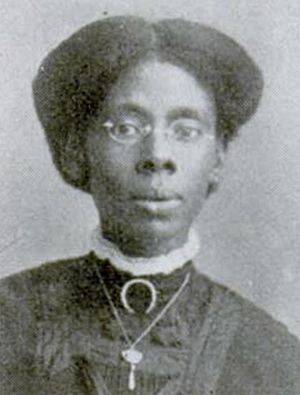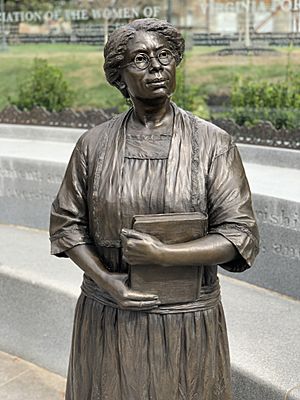Virginia Randolph facts for kids
Quick facts for kids
Virginia E. Randolph
|
|
|---|---|
 |
|
| Born | May 1870 Richmond, Virginia, U.S.
|
| Died | March 16, 1958 (aged 87) Richmond, Virginia, U.S.
|
| Occupation | Educator |
Virginia Estelle Randolph (born May 1870 – died March 16, 1958) was an important American educator in Henrico County, Virginia. She became the first "Jeanes Supervising Industrial Teacher" in the United States. Her boss, Jackson Davis, gave her this special job.
Virginia Randolph led a program that helped improve job training in schools across the southern U.S. This program was supported by the Jeanes Foundation. Her work is well-known for helping to start and improve vocational education, which teaches practical skills for jobs. Two schools in Henrico County Public Schools are named after her. In 2009, the Library of Virginia honored her as one of their "Virginia Women in History" for her amazing work in education.
Early Life and Learning
Virginia Randolph was born in May 1870. Her parents, Sarah Elizabeth Carter Randolph and Edward Nelson Randolph, had been slaves. Her mother worked in homes, and her father was a bricklayer. Virginia had three sisters: Mary, Sarah, and Emma. Emma was just one month old when their father passed away in 1874.
Her mother got married two more times. First, she married Joseph Anderson, who was a carpenter. Later, she married Joseph Minor, a laborer. The family went to the Moore Street Missionary Baptist Church. This church ran the Moore Street Industrial School. This school taught Black children both regular school subjects and hands-on skills. These skills included printmaking, carpentry, and sewing. Virginia Randolph was a member of this church her whole life. Her mother also taught her how to do handiwork.
Virginia grew up during the Reconstruction era, which was after the American Civil War (1861–1865). She went to schools in Richmond, Virginia. The state started a public school system in 1870. Virginia attended Baker School, which was the first public school built for Black students in Richmond.
Her next school was Richmond Colored Normal School. Today, it is called Armstrong High School. The Freedmen's Bureau started this school in 1867. It was a well-known high school. Its classes included botany (the study of plants), civil government, and geography. It also prepared students to become teachers. Virginia became a teacher when she was only 16 years old.
Career in Public Education
Virginia Randolph started her career as a school teacher. She taught for a short time in Goochland County. Then, in 1893, she taught in Hanover County. The next year, she got a teaching job with the Henrico County School Board.
She opened a one-room schoolhouse called the Mountain Road School. She worked hard to fix up the old building. She also traveled all over the county to find students to come to her school. As a teacher there, Virginia taught her students woodworking, sewing, and gardening. She also taught them regular school subjects. She believed that learning practical skills helped students find jobs. This was especially important if they could not go to high school.
Virginia also got people from the community involved. She started "school improvement leagues" and "Willing Worker Clubs." These groups helped people feel proud and active in their schools. Besides academics and skills, Randolph also thought it was important to help students grow good spirits and hearts. To do this, she started Sunday afternoon classes at the school. Faculty and students from Virginia Union University helped her, along with her minister, Reverend R. O. Johnson. Families like the Bryans and Stewards helped pay for her programs. Jackson Davis, the supervisor for Henrico County Schools, also supported her work.
In 1908, Mr. Davis chose her to be the first "Jeanes Supervising Industrial Teacher" in the United States. Anna T. Jeanes was a rich Philadelphia Quaker woman. She set aside $1 million to create a fund. This fund helped support and improve rural schools for African American students in the South. The Jeanes Foundation used some of this money to hire Black "supervisors." These supervisors worked to improve job training programs for Black students. Jeanes supervisors helped improve schools in communities until 1968.
Virginia Randolph oversaw twenty-three elementary schools in Henrico County. She created the first training program for Black teachers who were already working. She also worked to make school lessons better. She had the freedom to plan her own work. She designed hands-on work and community self-help programs to fit what each school needed.
She wrote down her progress in a book called the Henrico Plan. This book became a guide for southern schools that received help from the Jeanes Foundation. This foundation later became known as the Negro Rural School Fund. Virginia Randolph's teaching ideas and methods were even used in Great Britain's African colonies.
On March 30, 1908, Virginia Governor Claude A. Swanson made a special announcement. After this, Virginia Randolph started the first Arbor Day Program in Virginia. She and her students planted twelve sycamore trees. Some of these trees are still standing today, like living monuments. Over the years, some trees were lost to disease. In 1976, the trees that remained were named the first notable trees in Virginia by the National Park Service.
In 1915, Randolph opened the Virginia Randolph Training School. Later, she added dormitories (places for students to live) for future teachers. This school was later renamed the Virginia Randolph Education Center. Virginia Randolph was also chosen to be on the Industrial School Board of Colored Children. This happened after another famous person from Richmond, Maggie L. Walker, passed away. For many years, Randolph also served on the Inter-Racial and Health Board for the state of Virginia.
After working for 57 years with Henrico County Public Schools, Virginia Randolph retired in 1949. In 1954, a foundation was started to honor her and give out scholarships.
Personal Life
Virginia Randolph never got married. She took in children whose parents could not care for them. These children lived at her house. She adopted Carrie B. Sample, who was one of about fifty children she took in and raised. Virginia Randolph passed away in Richmond on March 16, 1958, when she was 84 years old.
Lasting Impact

The Virginia Randolph Fund was started in 1936 to honor her. The Southern Education Foundation is a non-profit group. It was created in 1937 from four different funds that helped support education for Black people. These funds included the Peabody Education Fund, the John F. Slater Fund, the Negro Rural School Fund, and the Virginia Randolph Fund.
The Virginia Randolph Home Economics Cottage was turned into a museum in 1970 to remember Randolph. The Virginia Historic Landmarks Commission said the museum was a State Historic Landmark. In 1976, the museum was named a National Historic Landmark by the United States Department of Interior, National Park Service. Virginia Randolph reportedly had an office in this building. Her grave is also on the museum grounds.
The Academy at Virginia Randolph, which used to be called Virginia Randolph Community High School, is in Glen Allen, Virginia. It is named in her honor.
The Virginia Randolph Foundation, Inc. was formed in 1954. Every year, it gives scholarships to high school students in Henrico County. These scholarships help students who plan to go to a four-year college or university.

